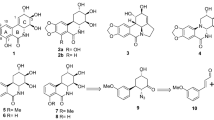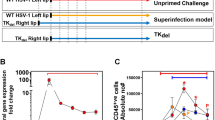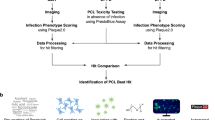Abstract
Psychological stress increases the susceptibility to herpes simplex virus type 1 (HSV-1) infection. There is no effective intervention due to the unknown pathogenesis mechanisms. In this study we explored the molecular mechanisms underlying stress-induced HSV-1 susceptibility and the antiviral effect of a natural compound rosmarinic acid (RA) in vivo and in vitro. Mice were administered RA (11.7, 23.4 mg·kg−1·d−1, i.g.) or acyclovir (ACV, 206 mg·kg−1·d−1, i.g.) for 23 days. The mice were subjected to restraint stress for 7 days followed by intranasal infection with HSV-1 on D7. At the end of RA or ACV treatment, mouse plasma samples and brain tissues were collected for analysis. We showed that both RA and ACV treatment significantly decreased stress-augmented mortality and alleviated eye swelling and neurological symptoms in HSV-1-infected mice. In SH-SY5Y cells and PC12 cells exposed to the stress hormone corticosterone (CORT) plus HSV-1, RA (100 μM) significantly increased the cell viability, and inhibited CORT-induced elevation in the expression of viral proteins and genes. We demonstrated that CORT (50 μM) triggered lipoxygenase 15 (ALOX15)-mediated redox imbalance in the neuronal cells, increasing the level of 4-HNE-conjugated STING, which impaired STING translocation from the endoplasmic reticulum to Golgi; the abnormality of STING-mediated innate immunity led to HSV-1 susceptibility. We revealed that RA was an inhibitor of lipid peroxidation by directly targeting ALOX15, thus RA could rescue stress-weakened neuronal innate immune response, thereby reducing HSV-1 susceptibility in vivo and in vitro. This study illustrates the critical role of lipid peroxidation in stress-induced HSV-1 susceptibility and reveals the potential for developing RA as an effective intervention in anti-HSV-1 therapy.
Similar content being viewed by others
Log in or create a free account to read this content
Gain free access to this article, as well as selected content from this journal and more on nature.com
or
References
Marcocci ME, Napoletani G, Protto V, Kolesova O, Piacentini R, Li Puma DD, et al. Herpes simplex virus-1 in the brain: the dark side of a sneaky infection. Trends Microbiol. 2020;28:808–20.
Singh N, Tscharke DC. Herpes simplex virus latency is noisier the closer we look. J Virol. 2020;94:e01701-19.
De Chiara G, Piacentini R, Fabiani M, Mastrodonato A, Marcocci ME, Limongi D, et al. Recurrent herpes simplex virus-1 infection induces hallmarks of neurodegeneration and cognitive deficits in mice. PLoS Pathog. 2019;15:e1007617.
Piret J, Boivin G. Immunomodulatory strategies in herpes simplex virus encephalitis. Clin Microbiol Rev. 2020;33:e00105-19.
Bello-Morales R, Andreu S, Lopez-Guerrero JA. The role of herpes simplex virus type 1 infection in demyelination of the central nervous system. Int J Mol Sci. 2020;21:5026.
Li W, Luo Z, Yan CY, Wang XH, He ZJ, Ouyang SH, et al. Autophagic degradation of PML promotes susceptibility to HSV-1 by stress-induced corticosterone. Theranostics. 2020;10:9032–49.
Pan MH, Zhu SR, Duan WJ, Ma XH, Luo X, Liu B, et al. “Shanghuo” increases disease susceptibility: Modern significance of an old TCM theory. J Ethnopharmacol. 2020;250:112491.
Yan C, Luo Z, Li W, Li X, Dallmann R, Kurihara H, et al. Disturbed Yin-Yang balance: Stress increases the susceptibility to primary and recurrent infections of herpes simplex virus type 1. Acta Pharm Sin B. 2020;10:383–98.
Mora F, Segovia G, Del Arco A, de Blas M, Garrido P. Stress, neurotransmitters, corticosterone and body-brain integration. Brain Res. 2012;1476:71–85.
Wu Y, Luo X, Zhou Q, Gong H, Gao H, Liu T, et al. The disbalance of LRP1 and SIRPalpha by psychological stress dampens the clearance of tumor cells by macrophages. Acta Pharm Sin B. 2022;12:197–209.
Bouayed J, Rammal H, Soulimani R. Oxidative stress and anxiety: Relationship and cellular pathways. Oxid Med Cell Longev. 2009;2:63–7.
Guo H, Zheng L, Xu H, Pang Q, Ren Z, Gao Y, et al. Neurobiological links between stress, brain injury, and disease. Oxid Med Cell Longev. 2022;2022:8111022.
Diniz BS, Mendes-Silva AP, Silva LB, Bertola L, Vieira MC, Ferreira JD, et al. Oxidative stress markers imbalance in late-life depression. J Psychiatr Res. 2018;102:29–33.
Lim DW, Park J, Jung J, Kim SH, Um MY, Yoon M, et al. Dicaffeoylquinic acids alleviate memory loss via reduction of oxidative stress in stress-hormone-induced depressive mice. Pharmacol Res. 2020;161:105252.
Burtscher J, Copin JC, Rodrigues J, Kumar ST, Chiki A, Guillot de Suduiraut I, et al. Chronic corticosterone aggravates behavioral and neuronal symptomatology in a mouse model of alpha-synuclein pathology. Neurobiol Aging. 2019;83:11–20.
Gaschler MM, Stockwell BR. Lipid peroxidation in cell death. Biochem Biophys Res Commun. 2017;482:419–25.
Chen X, Kang R, Kroemer G, Tang D. Ferroptosis in infection, inflammation, and immunity. J Exp Med. 2021;218:e20210518.
Jia M, Qin D, Zhao C, Chai L, Yu Z, Wang W, et al. Redox homeostasis maintained by GPX4 facilitates STING activation. Nat Immunol. 2020;21:727–35.
Zhu H, Zheng C. The race between host antiviral innate immunity and the immune evasion strategies of herpes simplex virus 1. Microbiol Mol Biol Rev. 2020;84:e00099-20.
Dahchour A. Anxiolytic and antidepressive potentials of rosmarinic acid: A review with a focus on antioxidant and anti-inflammatory effects. Pharmacol Res. 2022;184:106421.
Jheng JR, Hsieh CF, Chang YH, Ho JY, Tang WF, Chen ZY, et al. Rosmarinic acid interferes with influenza virus A entry and replication by decreasing GSK3beta and phosphorylated AKT expression levels. J Microbiol Immunol Infect. 2022;55:598–610.
Ali S, Alam M, Khatoon F, Fatima U, Elasbali AM, Adnan M, et al. Natural products can be used in therapeutic management of COVID-19: Probable mechanistic insights. Biomed Pharmacother. 2022;147:112658.
Genis-Galvez JM. Role of the lens in the morphogenesis of the iris and cornea. Nature. 1966;210:209–10.
Reinert LS, Lopusna K, Winther H, Sun C, Thomsen MK, Nandakumar R, et al. Sensing of HSV-1 by the cGAS-STING pathway in microglia orchestrates antiviral defence in the CNS. Nat Commun. 2016;7:13348.
Cardozo FT, Larsen IV, Carballo EV, Jose G, Stern RA, Brummel RC, et al. In vivo anti-herpes simplex virus activity of a sulfated derivative of Agaricus brasiliensis mycelial polysaccharide. Antimicrob Agents Chemother. 2013;57:2541–9.
Yu Z, Xu J, Liu N, Wang Y, Li X, Pallast S, et al. Mitochondrial distribution of neuroglobin and its response to oxygen-glucose deprivation in primary-cultured mouse cortical neurons. Neuroscience. 2012;218:235–42.
Folch J, Lees M, Sloane Stanley GH. A simple method for the isolation and purification of total lipides from animal tissues. J Biol Chem. 1957;226:497–509.
Luo X, Gong HB, Gao HY, Wu YP, Sun WY, Li ZQ, et al. Oxygenated phosphatidylethanolamine navigates phagocytosis of ferroptotic cells by interacting with TLR2. Cell Death Differ. 2021;28:1971–89.
Wieckowski MR, Giorgi C, Lebiedzinska M, Duszynski J, Pinton P. Isolation of mitochondria-associated membranes and mitochondria from animal tissues and cells. Nat Protoc. 2009;4:1582–90.
Poller WC, Downey J, Mooslechner AA, Khan N, Li L, Chan CT, et al. Brain motor and fear circuits regulate leukocytes during acute stress. Nature. 2022;607:578–84.
Lee EH, Park JY, Kwon HJ, Han PL. Repeated exposure with short-term behavioral stress resolves pre-existing stress-induced depressive-like behavior in mice. Nat Commun. 2021;12:6682.
Luo Z, Liu LF, Jiang YN, Tang LP, Li W, Ouyang SH, et al. Novel insights into stress-induced susceptibility to influenza: corticosterone impacts interferon-beta responses by Mfn2-mediated ubiquitin degradation of MAVS. Signal Transduct Target Ther. 2020;5:202.
Valyi-Nagy T, Dermody TS. Role of oxidative damage in the pathogenesis of viral infections of the nervous system. Histol Histopathol. 2005;20:957–67.
Protto V, Tramutola A, Fabiani M, Marcocci ME, Napoletani G, Iavarone F, et al. Multiple Herpes Simplex Virus-1 (HSV-1) Reactivations induce protein oxidative damage in mouse brain: novel mechanisms for Alzheimer’s disease progression. Microorganisms. 2020;8:972.
Ling JX, Wei F, Li N, Li JL, Chen LJ, Liu YY, et al. Amelioration of influenza virus-induced reactive oxygen species formation by epigallocatechin gallate derived from green tea. Acta Pharmacol Sin. 2012;33:1533–41.
Hu S, Sheng WS, Schachtele SJ, Lokensgard JR. Reactive oxygen species drive herpes simplex virus (HSV)-1-induced proinflammatory cytokine production by murine microglia. J Neuroinflammation. 2011;8:123.
Ishikawa H, Barber GN. STING is an endoplasmic reticulum adaptor that facilitates innate immune signalling. Nature. 2008;455:674–8.
Assimes TL, Knowles JW, Priest JR, Basu A, Borchert A, Volcik KA, et al. A near null variant of 12/15-LOX encoded by a novel SNP in ALOX15 and the risk of coronary artery disease. Atherosclerosis. 2008;198:136–44.
Schurmann K, Anton M, Ivanov I, Richter C, Kuhn H, Walther M. Molecular basis for the reduced catalytic activity of the naturally occurring T560M mutant of human 12/15-lipoxygenase that has been implicated in coronary artery disease. J Biol Chem. 2011;286:23920–7.
Marques-Deak A, Cizza G, Sternberg E. Brain-immune interactions and disease susceptibility. Mol Psychiatry. 2005;10:239–50.
Kim HJ, Kim CH, Ryu JH, Kim MJ, Park CY, Lee JM, et al. Reactive oxygen species induce antiviral innate immune response through IFN-lambda regulation in human nasal epithelial cells. Am J Respir Cell Mol Biol. 2013;49:855–65.
Wang X, Michaelis EK. Selective neuronal vulnerability to oxidative stress in the brain. Front Aging Neurosci. 2010;2:12.
Rosato PC, Leib DA. Neurons versus herpes simplex virus: The innate immune interactions that contribute to a host-pathogen standoff. Future Virol. 2015;10:699–714.
Kigerl KA, de Rivero Vaccari JP, Dietrich WD, Popovich PG, Keane RW. Pattern recognition receptors and central nervous system repair. Exp Neurol. 2014;258:5–16.
Lin Y, Zheng C. A Tug of war: DNA-sensing antiviral innate immunity and herpes simplex virus type I infection. Front Microbiol. 2019;10:2627.
Prehaud C, Megret F, Lafage M, Lafon M. Virus infection switches TLR-3-positive human neurons to become strong producers of beta interferon. J Virol. 2005;79:12893–904.
Nazmi A, Mukhopadhyay R, Dutta K, Basu A. STING mediates neuronal innate immune response following Japanese encephalitis virus infection. Sci Rep. 2012;2:347.
Donnelly CR, Jiang C, Andriessen AS, Wang K, Wang Z, Ding H, et al. STING controls nociception via type I interferon signalling in sensory neurons. Nature. 2021;591:275–80.
Looker KJ, Garnett GP. A systematic review of the epidemiology and interaction of herpes simplex virus types 1 and 2. Sex Transm Infect. 2005;81:103–7.
Li W, Wang XH, Luo Z, Liu LF, Yan C, Yan CY, et al. Traditional chinese medicine as a potential source for HSV-1 therapy by acting on virus or the susceptibility of host. Int J Mol Sci. 2018;19:3266.
Luo Z, Kuang XP, Zhou QQ, Yan CY, Li W, Gong HB, et al. Inhibitory effects of baicalein against herpes simplex virus type 1. Acta Pharm Sin B 2020;10:2323–38.
Guan H, Luo W, Bao B, Cao Y, Cheng F, Yu S, et al. A Comprehensive review of rosmarinic acid: from phytochemistry to pharmacology and its new insight. Molecules. 2022;27:3292.
Elebeedy D, Elkhatib WF, Kandeil A, Ghanem A, Kutkat O, Alnajjar R, et al. Anti-SARS-CoV-2 activities of tanshinone IIA, carnosic acid, rosmarinic acid, salvianolic acid, baicalein, and glycyrrhetinic acid between computational and in vitro insights. RSC Adv. 2021;11:29267–86.
Bekut M, Brkic S, Kladar N, Dragovic G, Gavaric N, Bozin B. Potential of selected Lamiaceae plants in anti(retro)viral therapy. Pharmacol Res. 2018;133:301–14.
Acknowledgements
This study was partly supported by the Natural Science Foundation of Guangdong (2023B1515040016 and 2021B1515120023), the National Natural Science Foundation of China (Grant numbers 82125038, 82274123 and 82174054), the Local Innovative and Research Teams Project of Guangdong Pearl River Talents Program (2017BT01Y036), the Innovation Team Project of Guangdong Provincial Department of Education (2020KCXTD003) and GDUPS (2019), and the National Key Research and Development Program of China (2022YFC0867400). The authors (Rong-rong He and Yi-fang Li) also gratefully acknowledge the support of the K.C. Wong Education Foundation.
Author information
Authors and Affiliations
Contributions
YFL, RRH, and HK conceived and designed the research. JYW, XXC, XHW, and HEY performed the experiments. JYW, XXC, and XHW contributed to the acquisition and analysis of the data. JYW and SHOY prepared figures, tables, and the manuscript. YPW, WYS, LL, WJD. FH, XXS, and HK partly advised the research. YFL, RRH, and SHOY revised and approved the manuscript. All of the authors have approved the final manuscript.
Corresponding authors
Ethics declarations
Competing interests
The authors declare no competing interests.
Rights and permissions
Springer Nature or its licensor (e.g. a society or other partner) holds exclusive rights to this article under a publishing agreement with the author(s) or other rightsholder(s); author self-archiving of the accepted manuscript version of this article is solely governed by the terms of such publishing agreement and applicable law.
About this article
Cite this article
Weng, Jy., Chen, Xx., Wang, Xh. et al. Reducing lipid peroxidation attenuates stress-induced susceptibility to herpes simplex virus type 1. Acta Pharmacol Sin 44, 1856–1866 (2023). https://doi.org/10.1038/s41401-023-01095-6
Received:
Accepted:
Published:
Issue date:
DOI: https://doi.org/10.1038/s41401-023-01095-6
Keywords
This article is cited by
-
Rosmarinic Acid inhibits Pseudorabies Virus (PRV) infection by activating the cGAS-STING signaling pathway
BMC Microbiology (2025)
-
Unveiling the crossroads of STING signaling pathway and metabolic reprogramming: the multifaceted role of the STING in the TME and new prospects in cancer therapies
Cell Communication and Signaling (2025)
-
Different action of glucocorticoid receptor in adipose tissue remodelling to modulate energy homeostasis by chronic restraint stress
Lipids in Health and Disease (2025)
-
Wogonin attenuates septic cardiomyopathy by suppressing ALOX15-mediated ferroptosis
Acta Pharmacologica Sinica (2025)
-
Phospholipid peroxidation in macrophage confers tumor resistance by suppressing phagocytic capability towards ferroptotic cells
Cell Death & Differentiation (2024)



